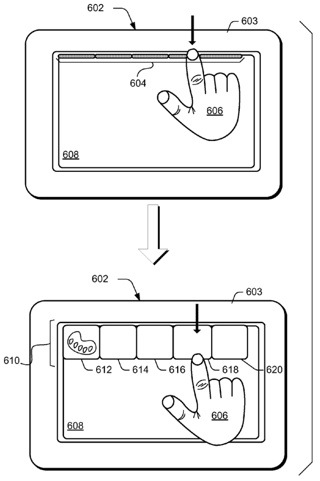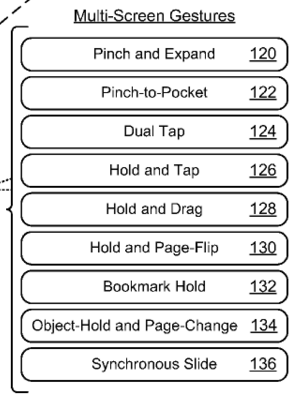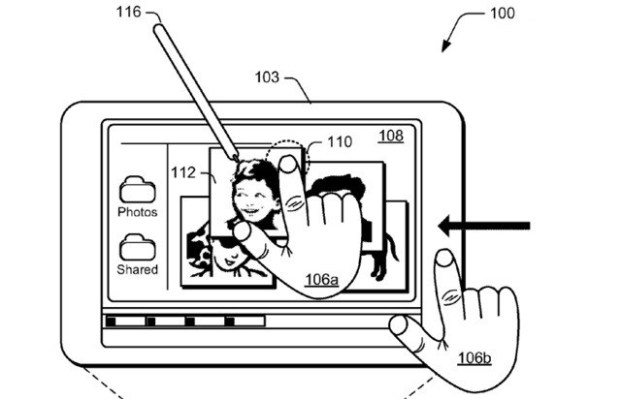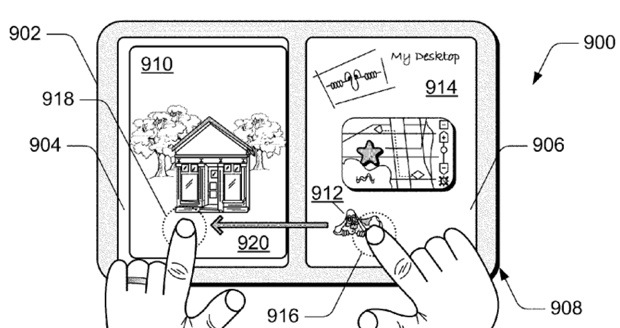(Update: The patents listed have not been granted, just recently made public.)
Back in February of 2010, Microsoft applied for a number of patents related to touchscreen gestures on a tablet. Many of them concern a dual-screen device, conjuring images of the once highly-anticipated Courier slate. The others focus mainly on bezel gestures. Those patents have gone public now, though they have not in fact been granted yet.
With IP wars raging across the globe, it’s certainly worth taking a look at the technology that Microsoft is attempting to lay claim to. So off we go:
 Off-Screen Gestures to Create On-Screen Input:
Off-Screen Gestures to Create On-Screen Input:
This one’s pretty interesting. It basically brings the bezel into the equation as far as gestures go. The patent provides for single-touch gestures, multi-finger same-hand gestures, and multi-finger different-hand gestures, all of which can operate along the bezel moving from the inside-out, or the outside-in. Now all Microsoft needs is to multi-toe different-foot gestures and the bezel is theirs. There’s also mention of bezel gestures inciting a drop-down menu.
We’ve seen something similar to this on the BlackBerry PlayBook. To wake the device up you slide your finger from the bottom bezel up into the screen. Multi-tasking requires the same gesture but from the sides of the slate into the screen.
Radial Menus with Bezel Gestures:
So here we have another bezel-related patent, this time concerned with Radial menus. It basically describes a way to access, navigate, and use a radial menu on the screen through use of bezel gestures. We haven’t seen a whole lot of radial/pie menus except on the Microsoft Surface and a little taste of one in Honeycomb’s browser. The Honeycomb pie menu works by placing half a finger on the screen, half on the bezel, although the screen is the only part of the device receiving the input.
Yet another bezel patent. But the last of the bunch, I promise. This one is indeed very similar to the first up there, but covers exactly what the name implies: multi-finger gestures. This one also covers the use of multi-finger gestures associated with one or many exposable (and apparently customizable) drawers. It also extends the gestures to use on a device with multiple screens.
And with that we can head on over to the other batch of patents, all focused on multi-screen gestures.
Multi-screen Dual Tap Gesture:
This next patent focuses mostly on the classic double-tap and how it’s used on dual- (or multi-) screen devices. From what I gather, it looks like this treats the double-tap as a way of going into full-screen mode, and what Microsoft is calling “pocketing” the tapped object. That is when the device is using a cross-screen combination display. However, if the device is in split-screen mode, the double-tap displays the tapped image in full-screen on one display, and “condensed” on the other.
 Multi-screen Pinch and Expand Gestures:
Multi-screen Pinch and Expand Gestures:
Another classic touchscreen gesture, but with the added awesomeness of a multi-screen system: pinch-to-zoom. Unlike the double-tap patent, this one doesn’t seem to have any mention of funky pinch-to-zoom split-screen commands. There’s really nothing super new about it except the introduction of multiple screens.
Multi-screen Bookmark Hold Gesture
This is pretty interesting. This particular patent describes a way to bookmark a certain “journal page” on the device by holding the corner of the “journal page” on the first screen, and performing a sliding motion on the second screen to indicate that it should be bookmarked. We assume that the use of the term “journal page” refers to all types of content. The bookmark is then a selectable link on the first screen, and is identifiable by a portion of the journal page displaying as the bookmark’s icon.
Multi-screen Hold and Page Flip Gesture:
The Hold and Page Flip patent has to do with split-screen viewing. By holding one finger on the screen whose content you’d like to continue viewing, and performing some type of unspecified “input motion” on the other screen, the content on the first screen will “hold,” while the content on the other screen will change, or “flip.”
Multi-screen Hold and Tap Gesture:
Last, but certainly not least, we have the hold and tap patent. This one is geared toward communication between the two screens. In one instance, holding a displayed object on the first screen and tapping the second will move said object from the first screen to the second screen, right where you tapped. In another example, the hold and tap gesture can be used to copy a held object onto the second screen. If the displayed object on the first screen happens to be a function, holding that function and tapping the second screen will apply that function to a displayed object on the second screen.
Who knows when, if ever, these patents will come to fruition? But with Microsoft attempting to control the technology, other tablet designers should take note of these patents. Especially if multi-screen devices are in the works (read: Sony).
[via Microsoft News]

